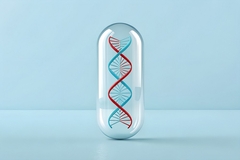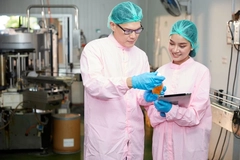Calcium-Rich Foods to Prevent Osteoporosis

There is no known cure for osteoporosis, but evidence shows that prevention, early diagnosis and treatment can address the prevalence and debilitating effects of this disease.
20/10/06 Osteoporosis, a disease characterized by low bone mass that often leads to fractures of the hip, spine and wrist, affects more than 5 million Californians, most of whom are women. In observation of World Osteoporosis Day on October 20, Dairy Council of California offers tips to help women and their families reduce their risk of osteoporosis throughout their lifetimes by eating a healthy diet rich in calcium and other bone-building nutrients, and participating in weight-bearing cardiovascular activities.
An estimated 55,000 osteoporosis-related fractures occur annually in California, and treatment costs for these incidents exceed $2.4 billion. Although its effects are not realized until later in life, inadequate calcium intake and lack of physical activity during childhood and adolescence are among the factors that significantly increase the risk of developing osteoporosis. There is no known cure for osteoporosis, but evidence shows that prevention, early diagnosis and treatment can address the prevalence and debilitating effects of this disease. By using a whole-family approach to bone-building foods and activities, younger children will benefit by building peak bone mass while they are young and adults may reduce the rate of bone density loss later in life.
"Parents have total control over what their child eats, drinks and does from the time they are born until they start school, so early childhood is the best time to make milk, dairy products and activity part of the family lifestyle," said Laura K. Bachrach, M.D., professor of pediatrics at Stanford Medical Center. "I think parents give up on dairy too quickly. They may not realize the impact that this decision could have on their children's health later in life."
Meals Matter, Dairy Council of California's online consumer meal planning and nutrition resource, features an interactive Calcium Quiz to determine whether daily food choices provide adequate calcium. The tool can be individualized for each member of the family, as calcium needs change based on factors like age, gender and supplement use. An important window of opportunity for building a lifetime of strong bones occurs from roughly age 9 to 14, when the body is growing and can most rapidly gain bone-building minerals. Peak bone mass, the strongest the bones will ever be, is reached by mid to late 20s. During this window, children and adolescents need three to four servings of dairy a day for optimal bone-building gains. Because adolescence is typically when teens forgo milk and dairy products for sodas and other snack foods, early family reinforcement and lifestyle adoption is very important.
"Without a doubt, milk and dairy products are the best sources of calcium and vitamin D in the American diet, so parents need to be creative in their efforts to put dairy into their children's diets," said Bachrach. "Focus on real foods like milk, cheese, yogurt or pudding before turning to supplements."
Beyond providing calcium and vitamin D, milk and dairy products are also high in essential vitamins and nutrients like potassium, phosphorus, magnesium and protein. Try pairing dairy products with other foods containing calcium like broccoli, almonds, beans, kale and calcium-fortified foods. For instance, a side dish of broccoli with melted cheese and sliced almonds is a bone-building bonanza.
"Exercise is the other piece of the bone-building puzzle," explains Bachrach. "Turn off the T.V., head to the park and get those growing bones moving!"
Exercise and exposure to sunlight are also important bone-building factors. At least 30 minutes of weight-bearing exercise like playing tag or hide-and-seek, walking, jumping rope, tennis or yoga most days of the week will help strengthen bones, and exercising outdoors can double the bone-building benefits. Sunlight allows the body to produce vitamin D, which the body needs to absorb calcium. Vitamin D also protects against soft, misshapen bones called rickets in children and osteomalacia in adults.
In addition to the Calcium Quiz, Meals Matter offers many quick and delicious recipes to bone up on calcium-rich foods.












